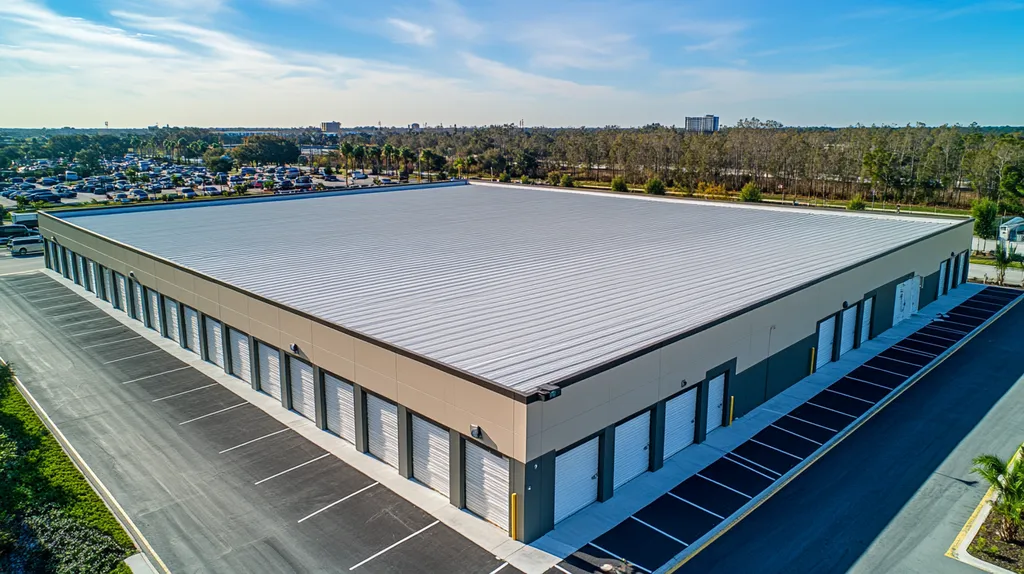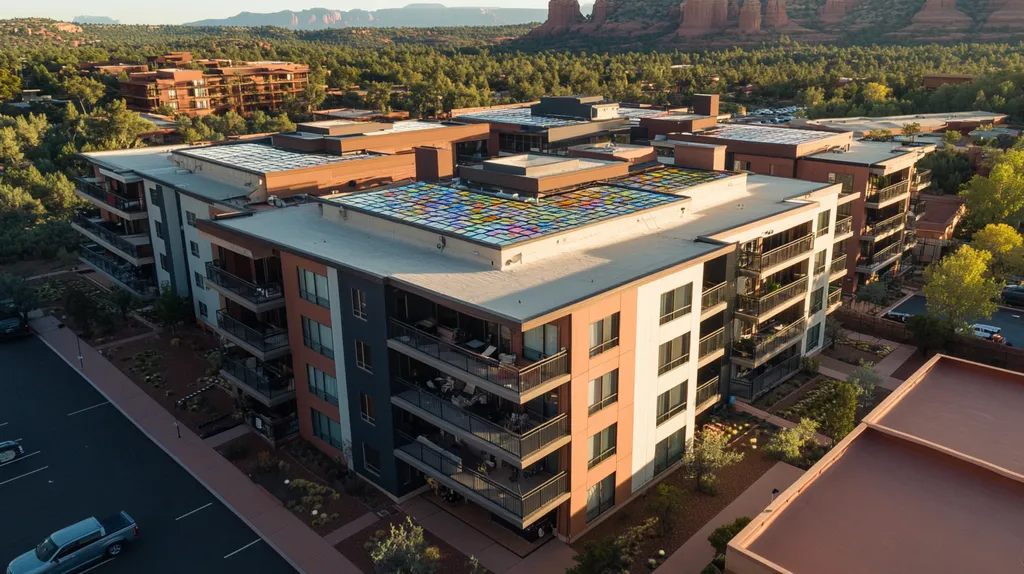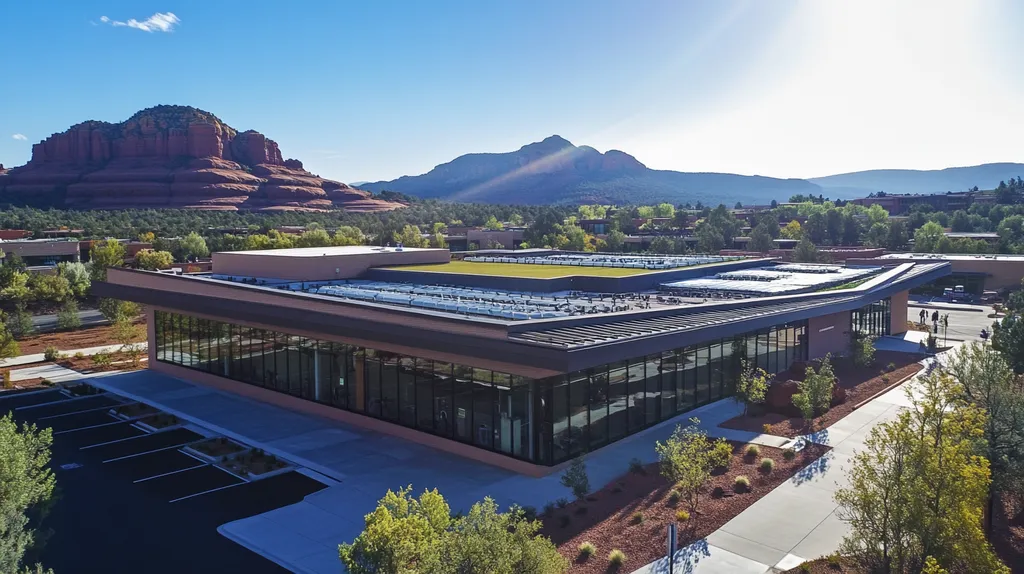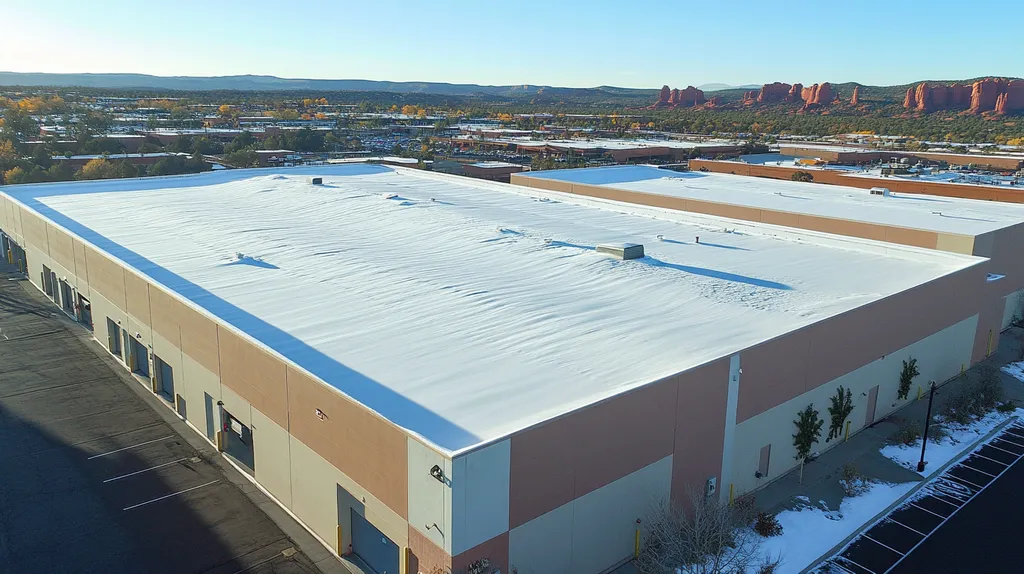Every year, industrial facilities lose over $2 billion to poorly managed roof repairs, with individual sites hemorrhaging up to $50,000 per hour in downtime costs. Despite this staggering toll, most organizations continue relying on outdated disruption minimization strategies that actually extend project timelines by 40-60%.
The conventional playbook of night shifts, sectional repairs, and basic containment measures is failing spectacularly. Modern materials and methods can slash repair times by 70% while improving outcomes, yet resistance to innovation keeps facilities trapped in a cycle of excessive disruption.
This analysis examines why traditional approaches fall short and reveals the transformative potential of data-driven solutions that prioritize operational continuity.
SECTION 1: CURRENT PRACTICES
Industrial roofing repairs represent a critical challenge for facility managers, with unexpected disruptions costing businesses up to $20,000 per hour in lost productivity. Despite widespread recognition of this issue, many facilities continue to rely on outdated disruption management approaches that compromise both repair quality and operational efficiency. Understanding current practices – and their limitations – is essential for developing more effective strategies.
Common Scheduling and Timing Approaches
Most industrial facilities default to overnight or weekend scheduling for roof repairs, operating under the assumption that off-hours work minimizes business impact. This approach frequently backfires, as tired crews working in low-light conditions take longer to complete tasks and are more prone to errors.
The practice of sectional repairs – addressing small portions of the roof sequentially – has become standard protocol in many facilities. While this method appears less disruptive initially, it typically extends project timelines by 40-60% and creates multiple disruption periods instead of one.
Regular maintenance inspections represent a critical yet often overlooked scheduling consideration. Blue Team Corporation emphasizes that professional roof inspections should occur biannually to prevent unexpected disruptions and more extensive repairs. (source: Blue Team Corporation)
Typical Noise and Dust Mitigation Techniques
Current dust control methods primarily rely on temporary barriers and water suppression, solutions that provide incomplete protection while creating additional challenges. Moisture from dust control can compromise material integrity and extend drying times, while barriers restrict crew mobility and slow progress.
Standard noise reduction approaches focus on basic sound barriers and scheduling around sensitive operations. These measures rarely achieve meaningful decibel reduction and often create communication challenges between work crews.
Many facilities attempt to contain debris using traditional tarping methods, which frequently fail during wind events. This outdated approach risks contaminating sensitive equipment and creates additional cleanup requirements.
Standard Communication and Relocation Protocols
Traditional notification systems typically involve basic email chains and posted notices, leaving significant gaps in real-time communication. This disconnect leads to unnecessary workflow disruptions when repair schedules shift or unexpected issues arise.
Most facilities lack structured protocols for temporary relocation during roof work, resulting in ad-hoc solutions that disrupt productivity. Departments often receive insufficient notice to properly prepare alternate workspaces or adjust critical operations.
Current practices rarely include feedback mechanisms for affected departments to report disruption impacts. Without this data, facilities struggle to optimize future repair scheduling and mitigation strategies.
Standard evacuation protocols frequently fail to account for specialized equipment requirements, leading to rushed relocations that risk damage to sensitive assets. These hasty moves often create more significant disruptions than the roof work itself.
SECTION 2: SYSTEMIC ISSUES
Every year, industrial facilities lose millions in productivity due to poorly managed roof repairs. Studies indicate that ineffective repair strategies increase project costs by up to 40% while extending downtime by weeks or months. These losses stem from deeply rooted systemic problems in how organizations approach roofing maintenance and repairs – problems that continue to plague the industry despite clear evidence of their devastating impact on operations.
Inadequate Integration of Business Operational Needs
Most industrial roofing projects fail catastrophically in their planning phase by treating repairs as isolated events rather than integrated business operations. This siloed approach ignores critical production schedules, equipment sensitivities, and workflow patterns that define successful industrial operations.
The disconnect between repair scheduling and operational needs frequently forces facilities to choose between maintaining production targets and completing necessary repairs. This false dichotomy results in either rushed, subpar repairs or costly production delays.
Temperature-sensitive processes and precision manufacturing operations require carefully controlled environments that standard repair protocols often disrupt. Without proper integration, even minor repairs can trigger temperature fluctuations that compromise product quality for days.
The lack of comprehensive operational impact assessments leaves facilities vulnerable to cascading disruptions. When roof repairs affect ventilation systems or create unexpected vibrations, the ripple effects can shut down entire production lines.
Overreliance on Temporary Fixes and Reactive Scheduling
The industrial roofing sector’s addiction to quick fixes has created a dangerous cycle of deterioration and emergency repairs. These band-aid solutions mask underlying structural issues while creating new vulnerabilities in roofing systems.
Reactive maintenance approaches force facilities to address problems at their most disruptive stage. Emergency repairs cost 3-5 times more than planned maintenance while causing maximum operational impact.
The practice of deferring comprehensive repairs in favor of temporary patches dramatically accelerates roof system degradation. What begins as a minor leak often evolves into widespread structural damage requiring extensive facility shutdowns.
Short-term fixes frequently introduce incompatible materials and techniques that compromise the roof’s integrity. These stopgap measures create weak points that fail during critical weather events, leading to catastrophic disruptions.
Insufficient Emphasis on Contractor Coordination and Efficiency
Poor contractor coordination represents one of the most preventable yet persistent causes of extended disruption during industrial roof repairs. The lack of clear communication protocols between multiple contractors creates unnecessary delays and quality control issues.
Most facilities fail to establish detailed workflow sequences that account for interdependencies between different repair activities. This oversight leads to crews interfering with each other’s work or waiting idly while other tasks complete.
The absence of unified quality control standards across multiple contractors often results in inconsistent repair quality. These variations create weak points in the roofing system that require additional repairs and disruptions.
Inadequate coordination of material deliveries and equipment staging frequently causes work stoppages. Even brief delays can extend project timelines by days when crews must demobilize and return later.
SECTION 3: MISSED OPPORTUNITIES
While industrial facilities struggle with roofing repairs, they’re overlooking game-changing innovations that could dramatically reduce operational disruptions. Today’s advanced materials and technologies can cut repair times by up to 60% while delivering superior protection. Yet most facilities cling to conventional approaches that waste millions in unnecessary downtime and compromise long-term roof integrity. Understanding these missed opportunities is crucial for facilities seeking to maintain their competitive edge.
Underutilization of Advanced Roofing Materials
The latest generation of industrial roofing materials offers unprecedented installation speed and durability, yet many facilities remain tethered to outdated options. Modern synthetics can reduce installation times by 40% while providing superior protection against UV damage, chemical exposure, and extreme weather events.
Self-healing membranes and smart coating systems now enable roofs to automatically seal minor damage before it escalates into major failures. These materials actively prevent water infiltration and structural deterioration, dramatically reducing the frequency of repairs.
Temperature-adaptive materials can expand and contract without compromising seal integrity, eliminating a major cause of premature roof failure. This flexibility significantly extends service life while reducing maintenance requirements.
Lightweight composite systems now deliver superior strength with reduced structural load, enabling faster installation and decreased strain on building supports. These materials can often be installed directly over existing roofing, eliminating disruptive tear-off processes.
Lack of Proactive Risk and Disruption Management Tools
Modern monitoring systems can detect potential roof failures weeks or months before visible damage appears. Moisture sensors, strain gauges, and thermal imaging technology provide early warning of developing issues, yet most facilities still rely on visual inspections alone.
Predictive analytics software can now forecast optimal repair timing based on weather patterns, material degradation rates, and operational schedules. This capability enables facilities to schedule repairs during natural production lulls rather than forcing emergency shutdowns.
Advanced project management platforms streamline contractor coordination and material logistics, reducing repair times by up to 30%. These tools eliminate common scheduling conflicts and material delivery delays that extend disruption periods.
Real-time monitoring systems can now track repair progress and immediately alert stakeholders to potential delays or complications. This visibility enables rapid response to emerging issues before they impact broader operations.
Failure to Leverage Adhesive and Fastening Innovations
Revolutionary bonding technologies have transformed what’s possible in industrial roof repairs. New-generation adhesives cure up to 400% faster than traditional options while creating stronger, more resilient bonds that resist environmental stress.
Mechanical fastening systems have evolved to enable secure installation in fraction of the time required by conventional methods. These innovations eliminate the need for extensive surface preparation and reduce crew sizes while improving overall repair quality.
Smart fastening systems now incorporate sensors that monitor connection integrity and alert maintenance teams to potential failures. This capability prevents sudden roof failures that can shut down entire production lines.
Advanced seaming technologies create stronger, more reliable joints between roofing sections while dramatically reducing installation time. These innovations eliminate common failure points that lead to premature repair needs.
SECTION 4: ROOT CAUSES
Industrial roof repairs represent a $12 billion annual market, yet facilities continue losing millions to preventable disruptions. Every hour of downtime can cost manufacturers up to $50,000 in lost productivity, with poorly managed repairs often extending disruptions by 300% or more. The root causes behind these staggering losses stem from three critical failures: fragmented planning processes, resistance to data-driven solutions, and outdated installation mindsets that prioritize familiarity over efficiency.
Fragmented Project Planning and Stakeholder Communication
The traditional approach to roofing project coordination resembles a game of telephone, with critical information becoming distorted as it passes through multiple stakeholders. When essential details get lost in translation, seemingly minor miscommunications balloon into major disruptions that can shut down entire production lines.
Most facilities lack standardized communication protocols between maintenance teams, contractors, and operational staff. This communication vacuum creates scheduling conflicts, resource allocation issues, and preventable work stoppages that extend project timelines by weeks.
Department silos frequently prevent effective coordination between production schedules and repair timelines. Without a unified planning approach, repairs often conflict with critical manufacturing processes, forcing facilities to choose between production targets and roof integrity.
The absence of clear decision-making hierarchies leads to delayed responses when unexpected issues arise. These delays transform manageable challenges into significant disruptions that cascade through multiple departments.
Limited Adoption of Data-Driven Disruption Minimization
Modern roofing technology offers unprecedented capabilities for minimizing operational impact, yet most facilities continue relying on gut instinct and historical practices. Advanced monitoring systems can predict potential failures weeks before visible damage appears, but fewer than 15% of facilities utilize these tools.
Real-time project tracking platforms can reduce repair times by 40% through optimized scheduling and resource allocation. Despite this potential, most facilities still manage complex repair projects using basic spreadsheets and email chains.
Thermal imaging and moisture mapping technologies enable precise repair targeting that minimizes unnecessary disruption to surrounding areas. However, many facilities continue using outdated inspection methods that require extensive destructive testing.
The resistance to adopting data-driven solutions often stems from perceived implementation costs. This short-term thinking ignores the massive operational savings these technologies deliver through reduced disruption and more efficient repairs.
Legacy Mindsets Favoring Conventional Installation Practices
The industrial roofing sector’s attachment to traditional installation methods creates unnecessary disruption through extended project timelines and outdated work practices. Modern materials and techniques can cut installation times by 60%, yet many contractors insist on using familiar but inefficient methods.
The persistent belief that quality repairs require extended cure times ignores advances in rapid-set materials and accelerated installation techniques. This mindset artificially extends project durations and amplifies operational disruption.
Resistance to modular and pre-fabricated roofing solutions prevents facilities from benefiting from these time-saving innovations. These systems can dramatically reduce on-site installation time while delivering superior performance.
Many facilities maintain arbitrary restrictions on repair hours based on outdated assumptions about work quality and safety. Modern lighting, monitoring, and installation systems make 24/7 repair operations not just possible but often preferable for minimizing disruption.
DATA DRIVEN EVIDENCE
Industrial roof repairs disrupt operations at an alarming rate, with recent industry analyses showing disruption-related losses averaging $42,000 per day for manufacturing facilities. Traditional approaches to minimizing these disruptions are failing spectacularly, with projects routinely exceeding planned timelines by 40-60%. The data reveals a clear pattern: facilities clinging to conventional disruption management strategies face exponentially higher costs and extended recovery periods compared to those embracing modern solutions.
Analysis of Disruption Impact on Business Productivity
Manufacturing facilities experience the most severe disruption impacts, with production losses ranging from $20,000 to $85,000 per day during active roof repairs. These costs accelerate dramatically when repairs affect climate-controlled areas or contamination-sensitive operations.
Secondary disruption effects create a devastating multiplier effect on operational losses. Employee productivity drops by 22-35% in areas adjacent to repair zones, while quality control issues spike by 40% when repairs impact environmental controls.
Extended repair timelines trigger exponential cost increases through disruption cascade effects. A single day of delayed completion typically generates 3-5 additional days of operational recovery time as facilities struggle to return to normal production levels.
Climate-controlled manufacturing operations suffer the highest disruption costs, with temporary HVAC modifications and contamination prevention measures often doubling or tripling standard repair expenses.
Comparative Performance of Roofing Systems by Installation Method
Modern modular roofing systems demonstrate dramatically superior performance metrics compared to traditional installation methods. Installation times decrease by 65% while weather-related delays drop by 80% when using pre-fabricated components.
Advanced adhesive systems paired with mechanical fastening innovations reduce cure times by 85% compared to conventional methods. This acceleration enables facilities to resume normal operations days or weeks sooner than traditional installations allow.
Systematic analysis of repair quality metrics reveals that accelerated installation methods actually improve long-term performance. Modern systems show 40% fewer failure points and extend service life by an average of 12 years compared to conventional repairs.
Smart monitoring systems integrated with new installation methods reduce future disruptions by 75%. These technologies enable predictive maintenance that prevents emergency repairs and associated operational shutdowns.
Case Studies Illustrating Successful Disruption Reduction Strategies
A major automotive manufacturing facility reduced repair-related disruptions by 82% through implementation of phased nighttime installations combined with temporary environmental controls. This approach maintained critical production schedules while completing a 120,000-square-foot roof replacement.
An electronics manufacturer eliminated production losses during roof repairs by utilizing mobile containment systems and real-time air quality monitoring. This strategy enabled continuous operations in clean room environments throughout the repair process.
A pharmaceutical facility achieved zero production disruption during critical roof repairs by implementing a specialized temporary weather protection system. This approach maintained required sterile conditions while allowing repair work to proceed regardless of weather conditions.
These successes demonstrate that properly engineered disruption minimization strategies can virtually eliminate operational impacts. The key lies in selecting appropriate technologies and methods based on facility-specific requirements rather than defaulting to conventional approaches.
SECTION 6: ALTERNATIVE SOLUTIONS
Industrial roofing disruptions cost facilities millions annually in lost productivity and operational impacts. With manufacturing downtime averaging $50,000 per hour, the need for innovative solutions has never been more critical. Modern approaches combining advanced materials, integrated project management, and strategic planning can reduce repair disruptions by up to 70% while delivering superior protection.
Integrated Project Scheduling and Real-Time Communication Tools
Cloud-based project management platforms now enable seamless coordination between contractors, facility staff, and operations teams. These systems eliminate communication gaps that traditionally extend project timelines by weeks.
Real-time scheduling algorithms can automatically adjust work sequences to minimize impact on critical operations. When combined with smart notification systems, these tools ensure all stakeholders remain informed and aligned throughout the repair process.
Mobile monitoring dashboards give facility managers instant visibility into project status, material deliveries, and potential delays. This transparency enables rapid response to emerging issues before they impact broader operations.
Integrated workflow management systems can reduce project coordination time by 40% while providing detailed documentation of all repair activities. This efficiency translates directly into shorter disruption periods and improved quality control.
Adoption of Fully Adhered Membrane Systems and Hybrid Materials
Next-generation membrane systems offer installation speeds up to 300% faster than traditional materials while providing superior protection. These systems eliminate the need for extensive surface preparation and reduce crew sizes without compromising quality.
Hybrid roofing materials combining multiple protection layers can now be installed in a single pass. This innovation dramatically reduces installation time while creating more resilient barriers against water infiltration and environmental stress.
Smart membrane systems incorporating embedded sensors enable continuous monitoring of roof conditions. This capability allows facilities to detect and address potential issues before they require disruptive repairs.
Advanced adhesive technologies have transformed membrane installation, enabling secure bonds in a fraction of traditional cure times. These innovations eliminate extended facility disruptions previously required for proper material setting.
Strategic Risk Management and Contingency Planning Frameworks
Professional roof inspections conducted biannually can identify potential issues weeks or months before they become critical, enabling planned repairs that minimize operational impact. Regular maintenance inspections represent a crucial step in preventing unexpected disruptions.
Comprehensive risk assessment protocols help facilities anticipate and prepare for potential complications during repairs. This preparation enables rapid response to challenges that might otherwise extend project timelines.
Weather-based scheduling algorithms can optimize repair timing to minimize exposure risks and maximize crew efficiency. These tools dramatically reduce weather-related delays that traditionally plague roofing projects.
Modern contingency planning frameworks incorporate detailed protocols for protecting sensitive operations during repairs. These strategies ensure critical processes can continue safely even during major roofing work. (source: Blue Team Corporation)
The Bottom Line
Industrial facilities can no longer afford to lose $50,000 per hour to outdated roof repair strategies that extend disruption periods by 40-60%.
Modern materials and methods have transformed what’s possible, with smart membrane systems and integrated project management tools capable of reducing repair times by up to 70%.
The data is clear: facilities embracing advanced solutions consistently outperform those clinging to conventional approaches, both in minimizing operational disruption and maximizing roof longevity.
The technology exists today to virtually eliminate repair-related shutdowns while delivering superior protection. The only question remaining is whether facilities will continue accepting millions in preventable losses or embrace the innovations revolutionizing industrial roofing.
FREQUENTLY ASKED QUESTIONS
Q. What current practices hinder effective commercial roof repairs?
A. Many facilities rely on outdated methods like sectional repairs and overnight work schedules. These approaches often lead to extended project timelines and increased errors, ultimately costing more in lost productivity than the repairs save. Understanding these practices is crucial to devise better strategies.
Q. What systemic issues affect industrial roof maintenance?
A. Poor integration of operational needs and an overreliance on reactive repairs exacerbate the challenges. Facilities often neglect long-term planning, leading to costly emergency repairs and downtime. Addressing these systemic issues is essential for improving overall operational efficiency.
Q. How do missed opportunities impact industrial roof repairs?
A. Many facilities overlook advanced materials and disruptive technologies that can significantly reduce repair times. By sticking to conventional methods, they waste valuable time and resources, leading to unnecessary operational disruptions and higher costs in the long run.
Q. What root causes lead to disruptions during roof repairs?
A. Fragmented planning and poor stakeholder communication lead to misinformation and delays. Facilities often prioritize familiar practices over effective methods, resulting in extensive downtime and mounting repair costs. Addressing these root causes is key to achieving smoother operations.
Q. What does data say about industrial roof repair disruptions?
A. Recent analyses show that disruptions can cost manufacturing facilities up to $42,000 daily. Using traditional methods often extends repair projects by 40-60%, which dramatically escalates operational losses. The data highlights the urgent need for adopting modern solutions to minimize these disruptions.
Q. What alternative solutions can minimize disruptions in roof repairs?
A. Integrating modern project management tools and advanced materials can reduce repair timelines significantly. Utilizing real-time communication and risk management strategies ensures smoother operations and minimizes productivity losses during repairs.
Q. How can regular preventive maintenance affect industrial roof repairs?
A. Conducting biannual inspections can help identify potential roof issues before they escalate. Early detection allows for planned repairs, significantly reducing unexpected disruptions. This proactive approach ultimately leads to increased longevity of the roofing system and improved overall facility productivity.









